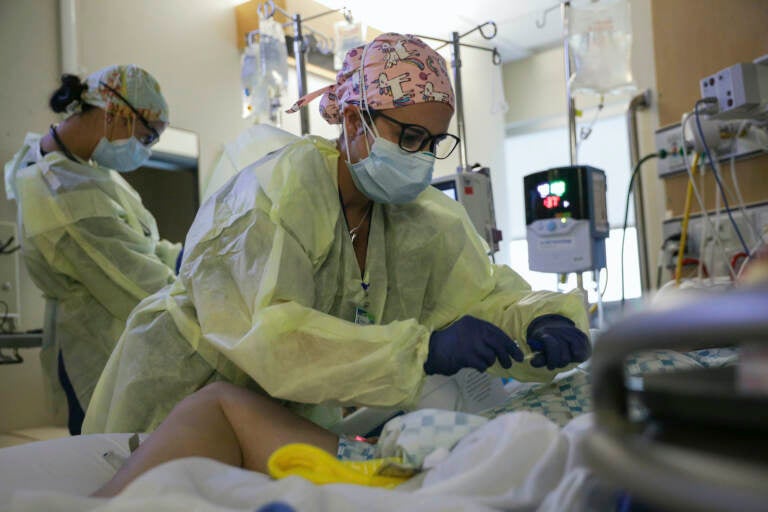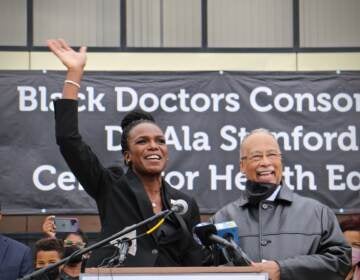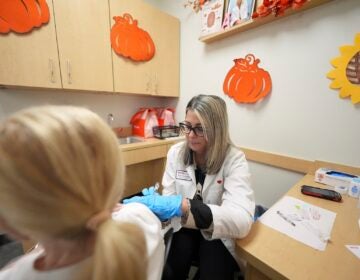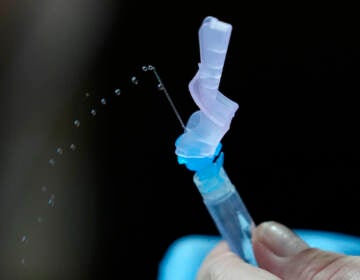How common are serious breakthrough COVID cases, really?
The short answer is: They’re still extremely rare. But experts warn that the way we talk about the vaccine has set it up to seem like a failure.

A critical care nurse administers an anti-viral medication to a COVID-positive patient at Kootenai Health regional medical center during response operations in Coeur d'Alene, Idaho, on Sept. 6, 2021. (Michael H. Lehman/DVIDS U.S. Navy/via AP)
Ask us about COVID-19: What questions do you have about the coronavirus and vaccines?
At first glance, the rate of so-called breakthrough COVID-19 infections in Philadelphia could instill fear into those who placed a lot of faith in the vaccines: Nearly a quarter of all COVID cases in October were among those who had been fully vaccinated, and the rate has crept up over time.
Add consideration of the booster doses recently authorized for people over 65 and other high-risk groups, and it could be enough to make any reasonable person believe that immunity conferred by the vaccine may be waning.
But if you hold the COVID vaccines to the standard applied to other vaccines — long-term protection from serious illness — that’s simply not the case, experts say.
“We’ve damned the vaccine,” said Paul Offit, an internationally recognized virology and immunology expert at Children’s Hospital of Philadelphia who sits on the Food and Drug Administration’s vaccine advisory committee. “By using the term ‘breakthrough,’ we’ve implied failure. That even though you’ve been vaccinated, if you get an asymptomatic or mildly symptomatic infection that somehow the vaccine has failed you, when it hasn’t.”
The best way to determine how well the vaccine’s immunity has held up in the face of the more contagious delta variant and the passage of time is not by looking at the proportion of vaccinated individuals that make up all COVID cases or hospitalizations, according to Offit. Since more and more people are vaccinated each month, we should expect that proportion to increase.
“In a perfect world, 100% of cases would be among vaccinated people, because it means everyone would be vaccinated,” said Offit.
Another way to measure frequency would be by looking at the proportion of vaccinated people who have gotten COVID-19, and more importantly, serious cases of the disease that landed them in the hospital.
In Philadelphia, just 0.2% of people who have been vaccinated tested positive for COVID-19 in October, a rate that has remained consistent since August. Just 0.01% of vaccinated people are hospitalized each month. That rate has been consistent since the vaccine became available.
As for deaths, though a greater share have been among the vaccinated each month, the death rate among the vaccinated has remained below 0.02% since the vaccine became widely available. Fewer than six people who were vaccinated in Philadelphia died of COVID-19 each month between January to August. In September and October, 14 people died each month.
It’s difficult to compare that rate to the rate among all unvaccinated Philadelphians. The city vaccinated some people who don’t live within its borders, and some Philadelphians got vaccinated elsewhere, making the total number of unvaccinated people hard to pinpoint.
Still, those rates are remarkably low and, more importantly, have not dramatically increased over time. So why the booster bonanza and fears of waning vaccine potency?
Offit attributes the misunderstandings to a failure to distinguish between the two types of immunity conferred through the COVID-19 vaccines.
The first is mediated by immunological memory cells, specifically memory B cells, which are the kind of cells that produce antibodies. That protection lasts for years, sometimes decades, and protects against serious illness. So far, all the data being seen in the United States indicates that the memory response from the COVID-19 vaccines is holding up against the delta variant, among all age groups, and among all the types of vaccines. That means it hasn’t gotten worse at preventing illness serious enough for people to seek medical attention.
The other type of immunity is shorter-lived, and is achieved through the neutralizing antibodies present in a person’s bloodstream at the time of exposure. Those antibodies prevent any infection, including mild or asymptomatic ones. But those neutralizing antibodies invariably fade with any vaccine, which the data in Philadelphia and nationwide supports by the increase in COVID cases among the vaccinated.
Booster doses offer a new injection of those neutralizing antibodies, but Offit warned that there is no reason to believe that a third shot would be the last, since the short-lived antibodies will fade after this shot as well.
“What is it we’re trying to do? Are we trying to continue to keep neutralizing antibodies up?” asked Offit, adding that is not the goal we have for any vaccine. “Generally, we don’t care about asymptomatic or mildly symptomatic infection.”
Other compounding factors for the apparent waning immunity is that older people are more likely to be hospitalized and vaccinated, leading to an overall higher incidence of hospitalization among the vaccinated.
As Penn biostatistics professor Jeffrey Morris noted in his blog post about widely cited Israeli data that showed 60% of those hospitalized were vaccinated, when the rate is stratified by age group, the vaccine’s effectiveness significantly improves (due to a mathematical phenomenon called Simpson’s paradox).
Part of the reason public health officials have been concerned about even mild COVID cases among vaccinated individuals is the fear that vaccinated people can still spread the virus, thus prolonging the pandemic and putting the unvaccinated at risk.
Though the latest research does demonstrate that vaccinated individuals may shed virus, it appears to be a smaller amount and for less time than among those who aren’t vaccinated.
WHYY is your source for fact-based, in-depth journalism and information. As a nonprofit organization, we rely on financial support from readers like you. Please give today.




![CoronavirusPandemic_1024x512[1]](https://whyy.org/wp-content/uploads/2020/03/CoronavirusPandemic_1024x5121-300x150.jpg)




